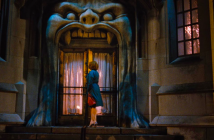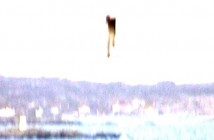
Dr. Strangelove or: How I Learned to Stop Worrying and Love the Bomb (1964)
Cast: Peter Sellers, George C. Scott, Sterling Hayden
Directors: Stanley Kubrick
Country: USA | UK
Genre: Comedy | War
Editor’s Notes: The following review is part of our coverage for TIFF’s Stanley Kubrick: A Cinematic Odyssey. For more information on upcoming TIFF film series visit http://tiff.net and follow TIFF on Twitter at @TIFF_NET.
The sound of rushing wind plays as the camera pans just above the clouds towards the tips of mountains peaking in the distance. The shot is a classic Kubrick device: by sweeping the screen with landscape shots he cleanses the viewers palate of everything else in their subconscious. The viewer has no choice, but be caught in a flying scene. A narrator (uncredited and rumored to be Peter Capell) cuts in and informs the audience of a secret Russian plot for a Doomsday Machine. The voice ends off in a question, positing the plot as an answer to the speculation of said machine. The opening’s tone takes on the color of a love story. As the B-52 and KC-135 tanker connect in mid-air, the tanker’s pump injects itself slowly into the bomber as both planes bounce and wiggle in unison. The movement is an erotic ballet set to the soft violins of the song Try A Little Tenderness. Only the title credits scrawled in a comic-like font designed by the design expert, Pablo Ferro, disengage the viewer from the refueling canned military footage. The title “Dr. Strangelove Or: How i Learned to Stop Worrying And Love The Bomb.” fades in and out between the credits and the planes. The displacement is jarring, setting the scene up for the surreal madness yet to come.
Is this a film about the love for the bomb or for the insanity that surrounds the bomb as a deterrent? Different views can be seen meshed in every seen.
Is this a film about the love for the bomb or for the insanity that surrounds the bomb as a deterrent? Different views can be seen meshed in every seen. The settings become just as important as the characters that inhabit them. A long shot, and there are many in the film, reveals details of Jack D. Ripper’s (played by Sterling Hayden who came out of retirement for the role), office: there’s a display of antique guns on the far wall; an aerial view of the Pentagon on the side one; and photos of bombers decorate the rest of the wood panel walls. There’s an absurd amount of desks, tables, pens, and office detritus that litters this room. Only Ripper is in the room and he seems to be the only one that uses it. He has put the world at risk in his deranged view that the fluoride in the water is a plot by the Russians to rid the male population of their “precious bodily fluids.” Phallic imagery is all over the film, but most of all, in Ripper’s office. The ever lit cigar burns and finally is diminished into a stub as an allegory for his impotence.
 George C. Scott plays Gen. “Buck” Turgidson, a know-it-all career military man whose hatred for the Russians can only be matched by his love for Wrigley’s chewing gum. His constant chewing and replenishing of the wad is both an oral fixation and a way to tame his dramatic tics. Scott couldn’t understand why Kubrick had him act so over the top, even keeping a scene where he accidentally trips on the ultra-polished War Room floor, but it is one of the most memorable roles by Scott. His portrayal of Turgidson can look like a cartoon, but from the tics to the bombastic expressions, Scott nails down the narrative of an off-kilter general who empowers himself through patriotism instead of what’s good for the people he protects. “You can’t fight in here! This is the War Room!” but slapstick is right at home there through Scott.
George C. Scott plays Gen. “Buck” Turgidson, a know-it-all career military man whose hatred for the Russians can only be matched by his love for Wrigley’s chewing gum. His constant chewing and replenishing of the wad is both an oral fixation and a way to tame his dramatic tics. Scott couldn’t understand why Kubrick had him act so over the top, even keeping a scene where he accidentally trips on the ultra-polished War Room floor, but it is one of the most memorable roles by Scott. His portrayal of Turgidson can look like a cartoon, but from the tics to the bombastic expressions, Scott nails down the narrative of an off-kilter general who empowers himself through patriotism instead of what’s good for the people he protects. “You can’t fight in here! This is the War Room!” but slapstick is right at home there through Scott.
Slim Pickens’ Major “King” Kong is a satire of a typical American cowboy, but as far as Pickens knew, he played that character straight. He was given a copy of the script with his role, but knew very little about the rest of the film. The cockpit scenes, which include a young James Earl Jones (Lt. Zogg) in his first film role, are technical and can be seen as pretty serious, with the exception of Pickens. After he lists the items included in the emergency kits (gum, prophylactics, nylons, lipsticks), he exclaims, “Shoot, a fella’ could have a pretty good weekend in Vegas with all that stuff.” The scene where he rides the missile rodeo style into annihilation has been copied and parodied in many films and cartoons.
Dr. Strangelove is the standout role for Sellers in the film, not just because of the top billing, but it is one of the funniest roles he’s ever taken on.
Peter Sellers plays three roles: Group Capt. Lionel Mandrake, President Merkin Muffley, and Dr. Strangelove. The truth though is that there are few other hidden characters: for example, the Russian President Dimitri Kissoff. While Dimitri is never seen, he’s voiced through Muffley’s phone interactions with him.
“Why do you think I’m calling you? Just to say hello? Of course I like to speak to you! Of course I like to say hello! Not now, but any time Dimitri. I’m just calling up to tell you something terrible has happened. It’s a friendly call. Of course it’s a friendly call. Listen if it wasn’t friendly * pause * you probably wouldn’t have even got it!” – Muffley
Through this phone call and the Russian Ambassador’s (played by Peter Bull), reactions, Dimitri is seen, while never actually seen, as a drunken politician who’s more concerned about the politeness of the president than for the catastrophe that’s about to befall his country.
Sellers plays President Muffley as the main voice of reason in the War Room, but he also plays the neurotic Mandrake. Mandrake discovers Ripper’s insanity and tries to reason with him to abort the attack. When that fails, he is still met with obstacles, reminiscent of Sellers’ characterizations of Inspector Clouseau. Having been reduced to use a payphone to contact the outside world of the military complex, he asks his captor, Col. “Bat” Guano (played by Keenan Wynn), to shoot a pop machine for change. Guano replies deadpan, “You’re gonna have to answer to the Coca-Cola company.”
The vending machine, although a prop, stands for how powerful corporations were then and were to become later. The War Room is an iconic set and was originally supposed to be a poker table, symbolically representing the generals and politicians playing poker with the world’s fate. Turgidson’s bedroom is composed of wall to wall mirrors (making the challenging shots of it genius) signifying a narcissist who just so happens to think he has control over, not only his surroundings, but of the world itself.
Dr. Strangelove is the standout role for Sellers in the film, not just because of the top billing, but it is one of the funniest roles he’s ever taken on. Part German nazi and part insane scientist, Strangelove is restricted to a wheelchair and is afflicted by a hand that is out to kill him. The glove Sellers uses in the film, is a part of a pair he saw Kubrick used for adjusting hot lights. Sellers thought the gloves looked sinister and used one of them for the sentient hand in the film. You could say the hand is the fifth role Sellers plays since it “acts” out in nazi salutes, off camera masturbation, and homicidal attacks of its owner. Almost all of Seller’s scenes are improvised, which meant Kubrick let him play with characters left, right, and center with little boundaries. This, in turn, made for a set that was continually erupting in laughter. Kubrick’s obsessive use of takes is carried into the editing of the film. Kubrick had to cut away and edit much of the on set laughter. In one particular scene, when Strangelove repeatedly hits his hand, Peter Bull can be seen repressing giggles. Witnessing this just adds to the craziness of the scene and the comedic sophistication of the film.
Like all of Kubrick’s films the meat is in the details and there is so much in this film that it is mind-boggling to consider how the last of Kubrick’s black and white films is also the most colorful. From set design, to oddly named props (Turgidson references a book with the title, World Targets in Mega Deaths), the film is a cornucopia of Kubrick-isms.
Dr. Strangelove has been proclaimed by various critics as one of the best comedies ever made, or as one of the best anti-war flicks. Kubrick was very interested in humanity’s compulsion for war and was often saddened by it. I think it speaks more of his unique perspective of film as a medium for subversion, message, and the respect he had for his audience to mold his vision as an entirely different film within the viewer’s brain. Dr. Strangelove is a movie that is many things to many viewers, but most of all, it is an exemplary work of Kubrick’s genuine love of film and the power it can convey.
Dr. Strangelove is a movie that is many things to many viewers, but most of all, it is an exemplary work of Kubrick’s genuine love of film and the power it can convey.



